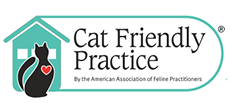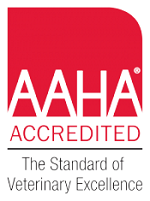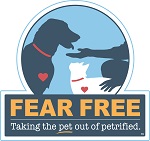A concept that has been gaining traction in the animal world is “cooperative veterinary care”. This is something that many zoos are starting to use, and basically it means training or conditioning animals to cooperate for veterinary procedures by using positive reinforcement and training.
Cooperative care is not the same as distraction. Sometimes when we have to do a procedure in the veterinary clinic like a vaccine or nail trim, we may use food to distract the pet long enough to get a procedure done with minimal stress. However, in the long run, this can backfire and the animal can develop an aversion to the food used if they start to make the association of something bad happening when they are given foods that have been used as distraction.
Cooperative care is something that is planned for ahead of time, taught and reinforced. The idea is to get an animal acclimated to procedures so they do not see them as something “bad”. Instead an association is made with high value treat rewards (rewards – not distraction), praise and “good things” happening.
Things that many animals can perceive as “bad” in a veterinary setting (or at home) may be nail trims, vaccines, muzzle placement, blood draws and ear cleanings. Most of these things don’t hurt terribly, but the animal becomes fearful because they do not understand what is being done, and most times they are being restrained for safety. At home, some procedures can cause a fear reaction over time and the animal can start to make negative associations with things related to the procedure. For example, a dog with a painful ear can become fearful and evasive with ear cleanings. First, the sensation of liquid being poured into the ears can be startling, and infected ears are often painful. If the owners are struggling to get the cleaning done, they can become frustrated or angry and resort to manual restraint to get the job done. Eventually the dog makes an association with the bottle of ear cleaner or the sight of cotton balls and becomes reactive any time these things are even brought out. They can even become anxious when the owners open a cabinet that the ear cleaner is normally kept.
If we can manage to prevent the negative association to form in the first place with cooperative care training, this is much less likely to happen. If a negative association has already happened, it will take more time and patience to turn that negative association into a positive one, but it certainly can be done.
Training your pet to accept and even look forward to routine procedures is similar to training tricks. For instance, if you wanted to train a dog to accept ear cleaning, you might start with bringing out a bottle of ear cleaner and giving high value treats and praise when the bottle is in your hand. You then put the bottle away. This is done until the dog does not react to the bottle and instead looks for treats. At first you are just trying to change the dog’s association with the bottle of ear cleaner. We want his brain to say “Oh, they have that bottle out. That means I will get yummy treats and praise”, rather than “Oh no! They have that bottle out! They are going to hold me down and put liquid in my ear! It may hurt and they will get upset with me!”
Depending on the dog, you may do need to stay at this step for a few days until the dog is happy to see the bottle of ear cleaner. You then slowly progress to having the bottle closer and closer to the ears (while continuing with treats and tons of praise) and eventually get to where you can lift the ear flap and touch the inner ear with the tip of the bottle. Once the dog is accepting of that, you advance to putting small amounts of liquid into the ear and mimicking the act of ear cleaning. If the dog becomes anxious, you back up and don’t advance further until the dog is comfortable at the step you are at. This can take days to weeks or even longer, depending on the dog’s previous experiences. A similar approach can be used for nail trimming, grooming, positioning for and pretending to draw blood, etc..
When doing this training, your demeanor and voice should indicate that this is fun and enjoyable. Talk in a voice that makes your dog happy and excited. Use high value treats that the pet does not get at any other time than when doing this training. Keep sessions short and stop and wait or try again a bit later if the pet shows fear or aversion. The key is to only progress when the animal is comfortable and cooperative with the step you are currently on.
Videos for cooperative veterinary care training can be found online or if you call our office, we have a handout we can give you that provides links to videos on and other resources with valuable information. A good Facebook group that has lots of resources, discussions and videos about training cooperative care can be found at https://www.facebook.com/groups/cooperativevetcare/
Veterinary procedures and routine maintenance like nail trims, ear cleaning and grooming don’t have to be a struggle. With a little preparation and careful creation of positive associations, these things can be much less stressful for pet and owner alike.




